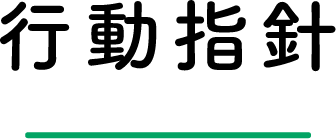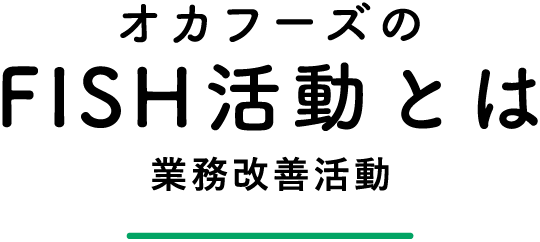- TOP>
- Company Information>
- Management Philosophy | Oka Foods
As a brand owner, we will strive to earn the trust of all our stakeholders by listening carefully to what our customers have to say and providing products and services that exceed their expectations.
Environmental maintenance is not just cleaning, but is considered a part of company culture. 01. To develop the habit of being aware of work methods and ways of thinking through environmental maintenance. 02. To prepare and create an environment that makes it easy to work whether at the office or at home. These are the two goals of environmental maintenance.

basic
After the radio calisthenics that everyone does at 8:30, we will continue as planned for approximately 25 minutes until 8:57. Environmental maintenance is given top priority in all activities, and is carried out by everyone "every day" with the exception of answering phone calls from customers. Furthermore, if we are unable to carry out the environmental maintenance due to unavoidable circumstances such as visiting customers in person or on a business trip, we will carry out the environmental maintenance after returning to the office or on another day.
We plan our schedules to ensure we have time to improve the environment, and we thoroughly consider and implement both the hard and soft aspects to improve it beyond its current state.
Sorting/tidying up
We clearly define what is necessary and what is not, and keep only what is necessary. We look for unnecessary work, try to digitize it, and try to stop it. We also try to digitize documents. We delete unnecessary data, emails, and files from our computers, regularly update our apps, and think about the users, storing and managing data according to set rules. We also thoroughly promote the "3 Teijin" (fixed location, fixed product, constant).
To make it easier for the next person to use, align the items, replenish any items that are running low, and always return items that have been used to their original position in the correct orientation (straight, horizontal, vertical).
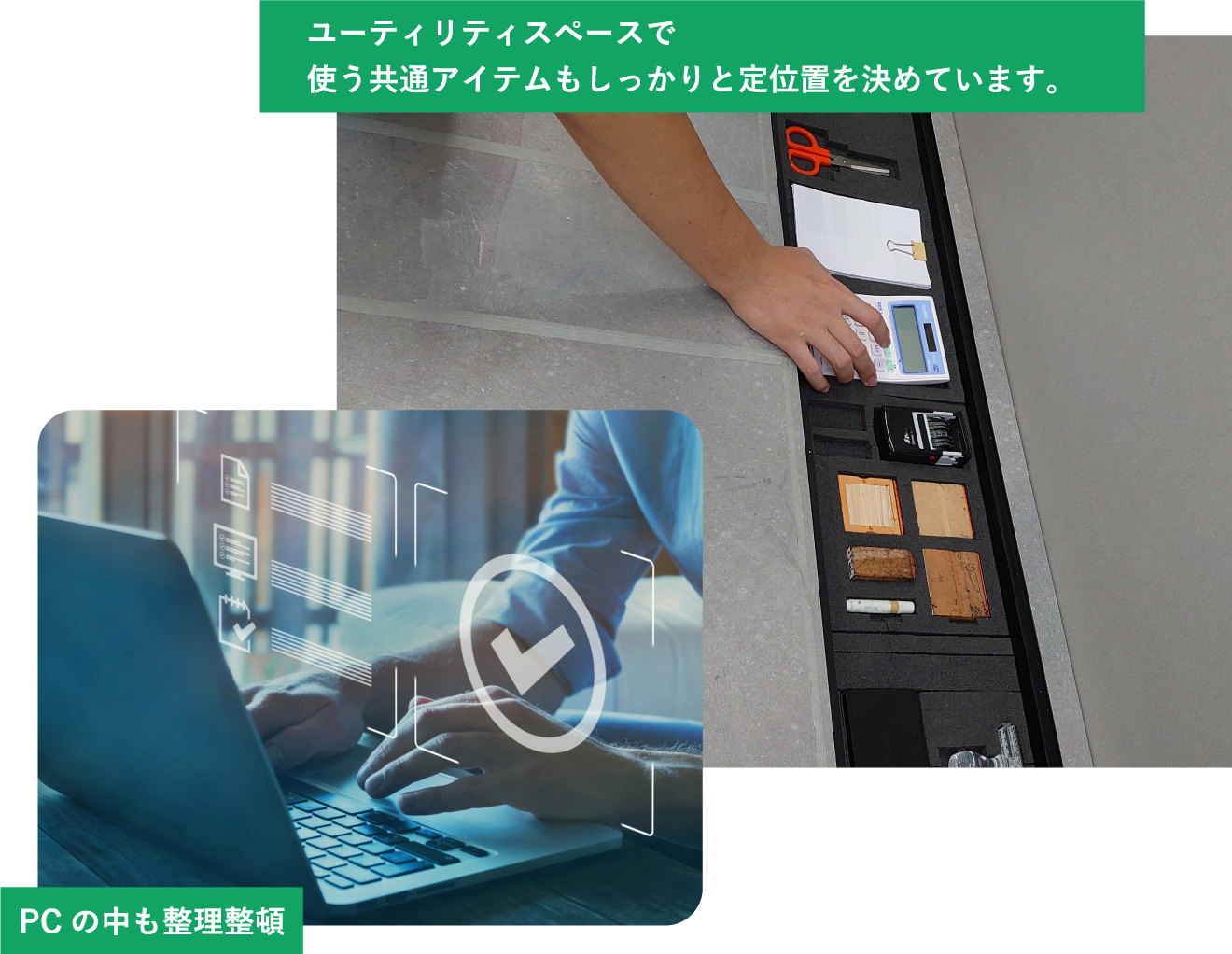
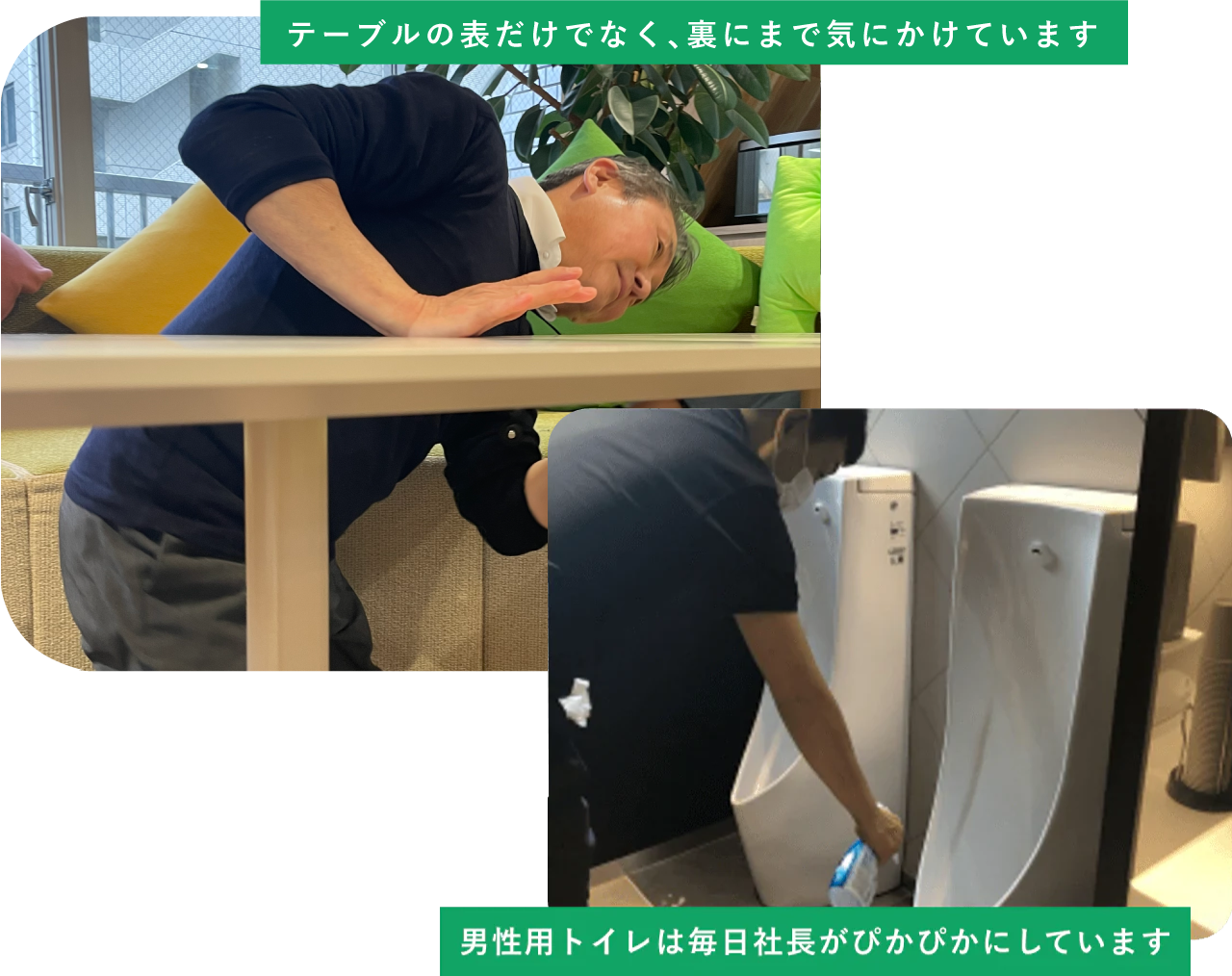
cleanliness
Following the plan, decide on a specific area that you will only clean today and thoroughly remove any dirt.
Gather all the cleaning supplies you need and make sure they are in the right place.
We will polish the company to a shine.
The toilet in particular is polished to a shine.
courtesy
When someone calls your name, you should look them in the eye and respond with "Yes." You should call the person's name loudly and with a smile, and greet them before they do, aiming to be "a company that offers the most refreshing greetings."
When using ZOOM (an online conference system), make sure your face is visible to the other party, and even if you are having a business meeting via ZOOM, dress appropriately so as not to be disrespectful to the other party.
I always check the content of the MK Platform (daily business report) and try to like and comment.
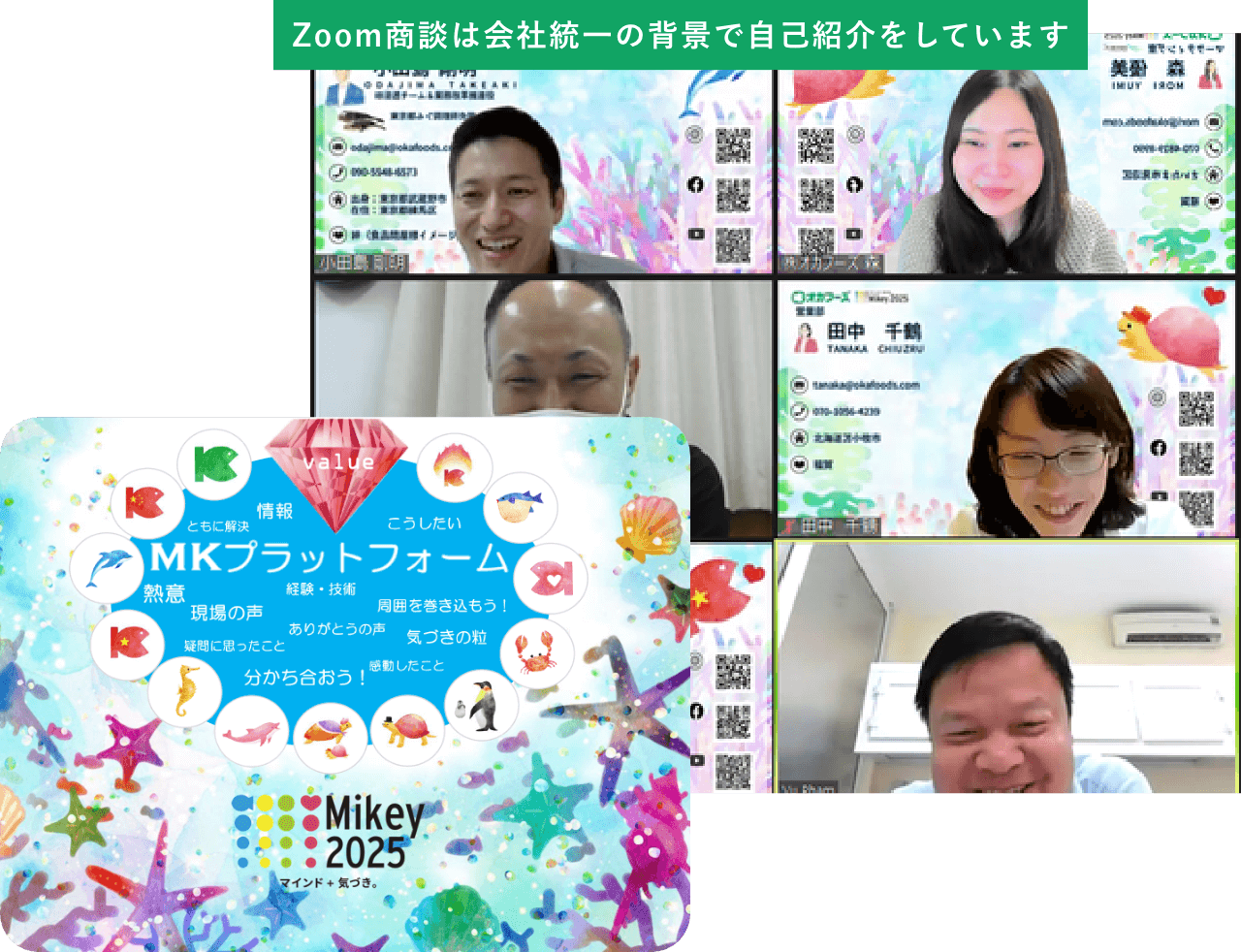
The beginning of environmental improvement
The yen began to weaken a year after President Oka took office in 2012, falling by nearly 20 yen to the dollar. This caused a significant increase in the prices of raw materials purchased overseas, which account for the majority of the company's costs, resulting in a significant drop in both revenue and profit. The company felt a sense of crisis and was growing increasingly anxious, as it felt that it would not survive unless it somehow changed its style.
First, in order to improve the company, we decided to first create an environment where employees could work comfortably. We increased the number of holidays per year and came up with measures to stimulate communication, and the main measure we started was "environmental improvement activities."
"Cleaning is not going to increase sales or profits!" was a common reaction from employees, and so Oka continued to clean the office alone every morning for several months. Some employees, seeing Oka silently cleaning, even expressed concern, wondering if something had happened to the president.
In December 2012, amidst this isolated and helpless situation, the company announced a policy that all employees would take 25 minutes after morning meetings to carry out environmental improvement activities, and put it into action.
Although the activity began, most employees were initially hesitant, and there were still strong voices saying that they should spend their time increasing sales rather than cleaning. However, as they continued to do so every day, little by little, changes began to appear.
By pursuing what should be, employees gradually developed the habit of thinking in a way that would make things better, such as, "If we provided baskets for putting luggage, it would be more convenient when guests come over," or "If we improved the conference room like this, it would be easier to use."
As more and more employees gradually became aware of these effects, they began to make various voluntary improvements to the environment and consciously apply them to their work.
Environmental Improvement Promotion Team
We have formed a team to promote environmental improvement. Members are selected from each department and serve for a basic term of one year.
We hold regular meetings to thoroughly implement the basics of environmental improvement and discuss what systems and practices we should implement to make our company a better place. We work passionately every day to create an environment where employees can work comfortably and to eliminate unnecessary work so that the time saved can be used to contribute to value creation for stakeholders.
-
Fighting
Have fighting spirit
-
Improvement
Improvement and progress
-
Shinka
evolution
-
Henka
change
The name was chosen from the initials of the above words and was chosen through an internal competition. It is a fitting name for our company, which specializes in fish.
Oka Foods had been engaged in environmental improvement activities for some time before that.
This activity has now been expanded to include not only tidying up the office, but also tidying up the work itself.
The purpose of FISH activities is to make our company a highly productive organization and to provide useful activities to stakeholders.
The goal is to enable employees to allocate their time resources to higher value-added tasks.
To achieve this, we aimed to build a system for fundamental and essential business improvement and to establish a culture of improvement within the company.
This business improvement activity targeted the entire company, including not only the back office but also the sales department.
Furthermore, initially, executives also participated in the activities by improving their own work flow.
About the base of our activities
The FISH activity was carried out based on the HIT method developed by System Science Co., Ltd.
The HIT method was adopted because it had the following advantages:
01.Rather than being led by a consultant, each employee takes the initiative to review their own daily work, identify problems, and make improvements. In other words, by continuing this activity, employees will naturally acquire the ability and mindset to make improvements.

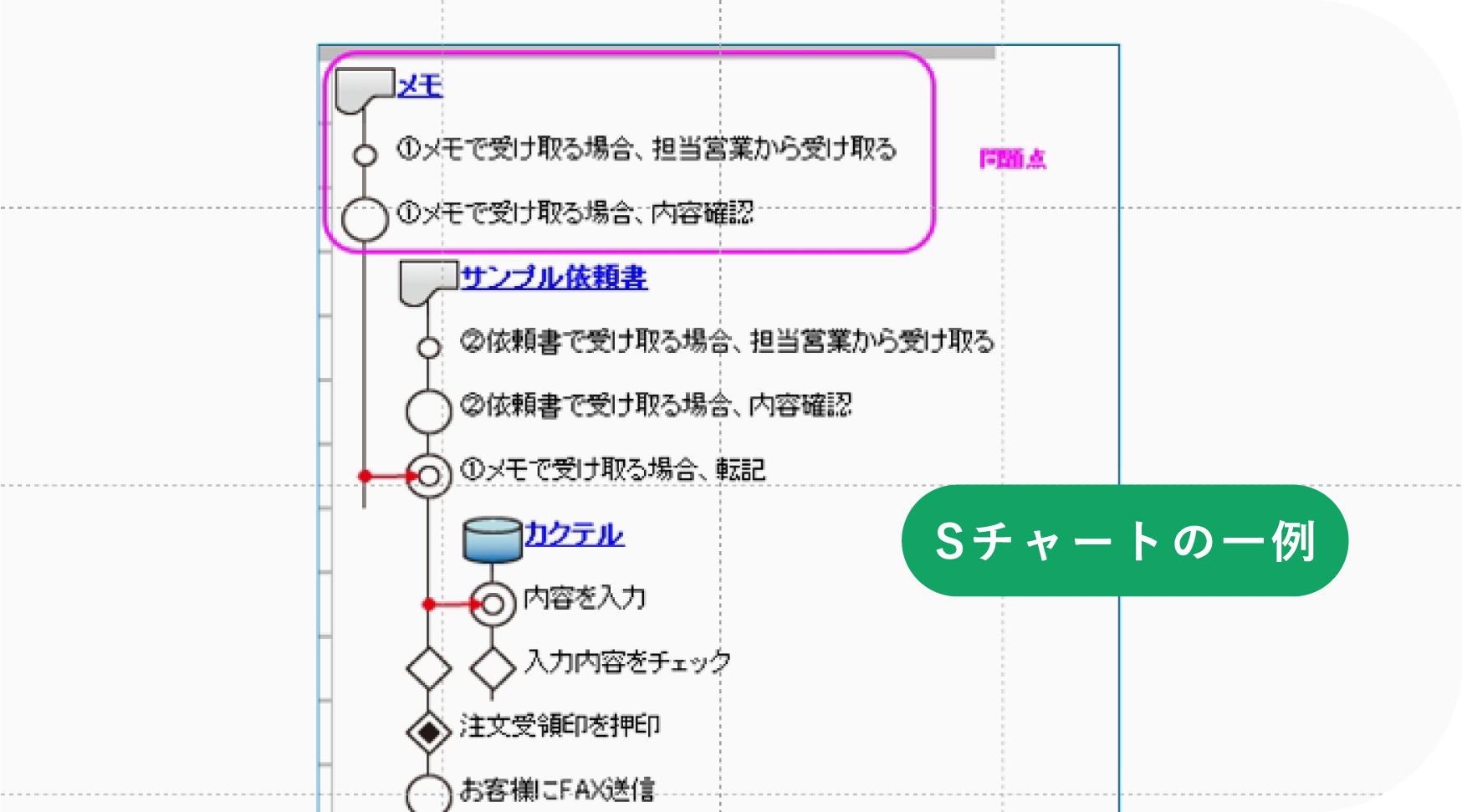
02.By using dedicated software, anyone can create an S-chart of their work flow. By visualizing work in the form of an S-chart, the creator can formalize their own work process. Not only that, it also allows for the inheritance and horizontal deployment of one's know-how. Furthermore, since S-charts can be used to clearly explain improvements to work processes, it has the added benefit of making it easier to gain the understanding of superiors and related departments. This tool not only creates flowcharts, but also aggregates information such as who has reduced how much work time, how many improvements each department has made this month, and what improvements have been stalled, making it useful for managing the progress of improvements.
03.We interviewed various business improvement consulting companies, but the HIT method had a high improvement effect, which was one of the deciding factors. For FISH activities, we adopted a bottom-up rather than top-down promotion system. For activities like this that "employees don't want to do," a top-down approach is generally considered more efficient. However, at our company, we aimed for young and mid-level employees to take the lead, learning and growing through activities to improve business operations, with managers remaining strictly followers.
Promotion system

A system in which promoters and employees improve their work through activities, and managers support their learning and growth.
Actual activities
The first thing we did was to thoroughly visualize the work. Each person made a list of their work.
We set a goal of 100 cases per person and identified all of our work within one month.
Usually, even if there is a person in charge of a job or a job title, they often do not have a clear understanding of what kind of work they actually do.
This results in oversights and tasks not being considered for improvement.
To prevent this from happening, we made a list of all the tasks we could think of and made them visible.
These activities are carried out in addition to carrying out normal business operations.
This places a significant burden on your time, increasing your working hours by an average of about 10%.
Many employees had a particularly difficult time during busy periods such as before consecutive holidays or at the end and beginning of the month.
However, everyone worked hard and as a result, 40 employees were able to visualize approximately 3,800 cases.
This included all tasks, regardless of their importance, such as serving tea to customers, reading e-mail newsletters, settling advance payments, stamping approval documents, and product development.
Next, regarding the visualized operations, we converted all of them into S-charts within six months of starting.
Although it was easy to create using dedicated software, it took a considerable amount of time to accurately describe the work.
Furthermore, we have made it mandatory to create and submit at least five improvement proposals per month for the S-charts that have been created.
This is shown in the graph below. As a result, the number of improvement proposals was 3,198.

In addition to individual improvements, we also held department-level review meetings once a week.
This is a meeting where individual improvement proposals are presented and discussed, and horizontal expansion and department-level improvements are considered, and it continues to this day in many departments.
In addition, a company-wide review meeting called the Output Review Meeting is also held.
This meeting is held once a month, where each department presents its outstanding proposals and improvement status, and everyone from the president to employees can ask questions and express their opinions about the improvement proposals.The president often makes immediate decisions on improvement proposals that are under consideration but not yet implemented, which has accelerated the speed of improvements.
Results of activities
First, the company's overall work hours were reduced by 17,317 hours between June 2017 and September 2018, or 444 hours per person. This is equivalent to approximately 40% of effective working hours.
The term "effective working hours" refers to the number of hours actually worked.
For example, even if you work 2,000 hours a year, that includes waiting time, travel time, toilet time, smoking time, and daydreaming time.
It includes a lot of time that is not directly related to work, such as chatting, and if you exclude that, it is said to be 1000 to 1200 hours. In other words, even if you work 2000 hours, your actual working time is only 50 to 60%.
Based on this idea, if we convert the time saved into hours, we can see that we have achieved a reduction of approximately 40% in work hours.
There are many individual improvements, but one example would be "reducing monthly settlements by half."
What previously took 10 working days to be completed can now be completed in 5 days.
We reviewed all of our existing business flow processes and took the following actions:
However, at this time, no improvements were made to the core system, only to the process.
Improvement Actions
 Requesting that the invoice be sent sooner
Requesting that the invoice be sent sooner In difficult cases
In difficult cases
Request by fax or email Download invoices from the internet (using macros)
Download invoices from the internet (using macros)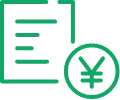 Aggregated from usage details
Aggregated from usage details Improvement and abolition of 4th-level operations
Improvement and abolition of 4th-level operations Shortened lead time
Shortened lead time
As a result, we aimed to halve our fiscal year end by June 2018, but we were able to achieve this ahead of schedule in April.
In addition, working hours were shortened by 30 minutes to 7.5 hours per day. Overtime was also reduced to zero, and hidden overtime was also significantly reduced.
Furthermore, the personnel structure of the department changed, with more than 30% of employees being transferred to newly established departments such as marketing, systems, and secretarial departments.
Not only that, but our employees have been able to spend more time making our stakeholders happy.
30% of employees transferred to newly established departments

Future activities
FISH activities were temporarily suspended due to the sudden shift to a work-from-home system following the outbreak of the coronavirus in early 2020.
It has since resumed. Improvement proposals are also being prepared from home, and output review meetings are being held remotely.
In order for Oka Foods to find more time to be of even greater service to our stakeholders,
We will continue our improvement activities, which are the source of this supply.
- TOP>
- Company Information>
- Management Philosophy | Oka Foods






